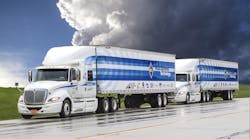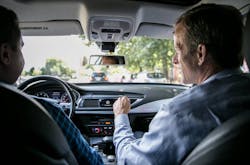A Senate hearing on autonomous trucks offered little new information for anyone who has monitored the rapid developments in recent years. It did, however, illustrate the increased attention the issue is receiving by Congress.
“Automated vehicle technology holds great promise to transform transportation in this country,” Sen. John Thune (R-SD) said in his opening statement. “But the most exciting aspect of this transformative advancement is the potential to save thousands of lives every year on our nation’s roadways.”
Thune is chairman of Senate Committee on Science, Commerce & Transportation, which called the Sept. 13 hearing on Capitol Hill. It was held as the Senate considers legislation that could give the Department of Transportation (DOT) the ability to set performance standards for autonomous vehicles.
A House version passed earlier in September excluded vehicles over 10,000 lbs. The Senate panel has not decided if whether it will attempt to include commercial vehicles.
The panelists testifying before the committee generally expressed support for linking all motor vehicles as any federal standards and regulations are developed.
Chris Spear, president of American Trucking Associations, said while he was not “pushing for more regulations,” on this particular issue it was critical the federal government take the lead, rather than letting each state create different rules for cars and trucks.
“Preserving a seamless set of safety standards across the country will help to minimize disruptions to the economy and the national supply chain, and support the development of new technology,” he said in prepared testimony.
Ken Hall, general secretary-treasurer of the Teamsters union, was the most cautious of all the panelists, expressing concern whether the technology could wipe out millions of truck driving jobs.
Yet, he and Spear were in general agreement when asked if they would support in the near-term regulations on lower levels of automation – thus ensuring that a driver would be needed in every vehicle.
Spear stressed that very few in the trucking industry believe a true driverless truck – Level 5 automation - will be a reality in the “foreseeable future.”
Besides the potential risk to jobs, cybersecurity and training needs were frequently cited by the senators on the committee.
At the same time, there was consensus the safety benefits are far too great to ignore.
“This is a game-changer for highway fatalities,” Deborah Hersman, president of the National Safety Council, said in a response to a question from Thune on the technology’s potential.
It was a sentient shared by Troy Clarke, chairman, president and CEO of Navistar Inc.
“We believe that these greater levels of self-driving technology will help reduce human error, which accounts for approximately 94 percent of all motor vehicle accidents,” he said.
Clarke also touted safety and fuel economy benefits of truck platoons, where two or more trucks are electronically linked.
Col. Scott G. Hernandez, chief of Colorado State Patrol, who participated in last year’s autonomous beer delivery in the state with Otto, assured senators the technology does “advance safety for trucks.”
“The proof of concept in Colorado indicates that self-driving vehicles will play a critical role in improving traffic safety and may reduce congestion in the future,” he said.
The role technology can play in reducing highway accidents was a main theme of DOT’s updated guidelines on autonomous vehicles, issued on Sept. 12.
“In the transportation sector, where 9 out of 10 serious roadway crashes occur due to human behavior, automated vehicle technologies possess the potential to save thousands of lives, as well as reduce congestion, enhance mobility, and improve productivity,” DOT said.
Secretary Elaine Chao released the updated document about one year after the Obama administration issued the first-ever guidance for autonomous vehicles.
The document includes 12 priority safety design elements for consideration, including cybersecurity, human machine interface, crashworthiness, consumer education and training, and post-crash ADS behavior.
The document also dives into the responsibilities state governments will have, even as the federal government takes some level of oversight into the emerging technology.
In particular, DOT said states will remain in charge of numerous areas, including licensing, enforcing traffic laws, conducing inspections and regulating vehicle insurance.
At the hearing, Sen. Richard Blumenthal (D-CT) was critical of the guidelines, calling them “anemic” and “a give away to the industry.”
ATA's Spear fired back, calling the document “a first step” and “a good foundation.”






